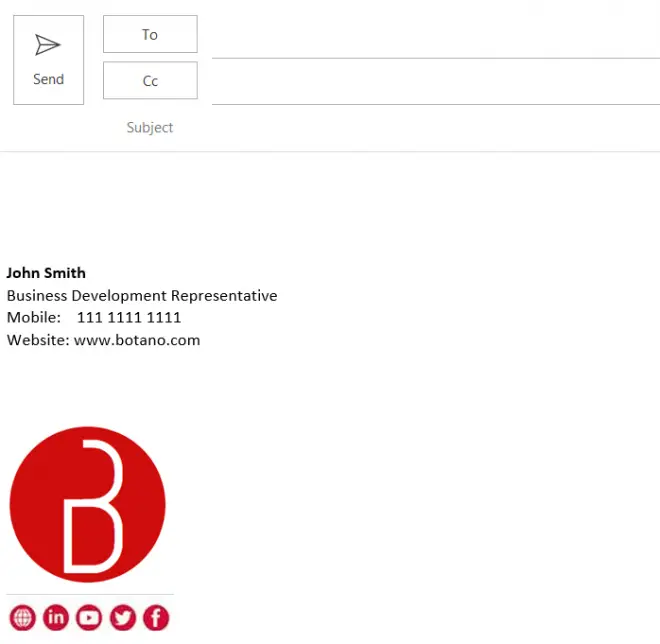You’re effectively throwing out business cards every time someone reads your email. You want it to seem professional and to represent the personality of your company. No, I wouldn’t give someone my phone number and email address on a piece of paper. Since then, the chances of it happening have greatly diminished. Certainly not! A signature on your email messages is a simple yet useful tool. In your Outlook signature, you may include images, links, and unique formatting or characters to help you customize your emails to each recipient. Your signature may show in a different format or may not appear at all depending on the recipient’s ability to read plain text. Add a plain-text email signature at the end of your signature.
1. Work something on your Outlook Signatures Folder
Make sure the Signatures folder is the first one to be picked. You can create a new plain text signature or change an existing one. After clicking “File,” pick “Options” from the left-hand box. Before sending the message, in Outlook’s Options dialog box, choose “Mail” as the recipient. Continue to hold down “Ctrl” while clicking “Signature,” and you’ll be taken to the Signatures folder, where you’ll discover files you’ll need to sign your emails, such as plain text copies of the signatures you’ve previously produced.

2. Signature Edit
It does, however, have a distinct extension:.txt. By double-clicking on the plain text link, you may access the plain text version of your signature. When you double-click the file, a text editor, such as Notepad or another, will open. If strange characters emerge in lieu of links or formatting, the process should be repeated. URLs, email addresses, and other text-based information can be added. This file should be preserved. The next time you send a plain-text email message to a recipient, Outlook will use it.
3. HTML could be the culprit
We’ve spoken about it a lot, but the disclaimer function in Office 365 (now Microsoft) isn’t for email signatures, despite its name. It can’t be used for anything else. When HTML is used in an Office 365 signature, it is common for the signature to not display in Outlook. As a result, you can’t use Office 365’s email signature management function. It is unable to incorporate images like logos, social media, and banners since the Office 365 disclaimer function does not differentiate between these types of photos. As a result, your email signature will seem different than you had anticipated. This concept will be much more effectively represented if you personally attach a photo to your signature. If you do this by hand, the receiver of your email will see a red “X” or a separate attachment. If this happens to you, your Office 365 signature may not display in your signature list. Maintaining them online needs the use of a third-party service.
To solve the problem, there must be a way to preserve all email signature photos online. Images can be hosted for free on Imgur or TinyPic. In the HTML code of your signature, you’ll discover a link to your images, which you may then insert into your signature. Many email clients, such as Outlook, will not enable you to send images saved outside of an email by default. The reason for this is security. They must first click the “Download Images” button before they can view the images you’ve emailed them.
After we imported it, my HTML email signature is no longer working in Office 365.
HTML in email signatures differs from HTML on websites for several reasons:
- Email clients exist in a greater range of varieties than browsers, emphasizing the small differences between them. Because mobile phones and tablets are so frequently used, it’s impossible to tell which device is reading your email.
- Consider how the receivers will perceive them. Photographs will not be permitted in your signature.
- Even if you have your logo on your website, many email applications will not display it unless the recipient requests it. Anyone who is interested in this should consider downloading it in its entirety.
Do you want your emails to always seem to include attachments? Nobody knows what your IT department will do with all of those extra bytes.
When the recipient answers, the sender’s email program immediately changes the message to HTML. Your post may look to have originated from a factory where something went tragically wrong a few answers later.
4. Office 365 Transport Rule
An Office 365 Transport Rule automatically inserts signatures at the end of an email chain. If the signature text isn’t already present in the current email reply or forward, Office 365 will keep adding it. Furthermore, it cannot identify where the signature should be placed. Your signature will show at the bottom of the page if you reply to five of the chat’s queries.
A Transport Rule exception must be configured to prevent the signature from being applied to every packet. As a result, your first email signature will be hidden, and you will not get any response signatures.
5. Blank Fields taking place in contact details
Each user’s signature may be filled using either Microsoft 365 or Azure AD. However, not all users will have identical contact information. Others may be unable to reach you by cell phone. It is possible that not all users will have access to internal extensions. The list might go on indefinitely, however, some signatures may lack contact information.
This field may be empty when users have a large number of contacts.
6. A signature problem in mobile device
Since so many individuals now work from home, there are countless examples of this on the internet.
Only plain-text signatures will be accepted because it is the format used by the vast majority of mobile devices. If you’re using iOS, you’ll notice that HTML operates quite differently from how it does on the web. The recipient will not be able to see your eye-catching images since all HTML code has been deleted.
Email signatures sent from mobile devices are commonly stripped of images.
It’s possible that you might convince consumers to create their own mobile signatures, but this is highly unlikely to happen in practice.
7. Email signature missing when composing a message
In the end, there’s nothing you can do about it. As though the message had been stamped with a postage stamp, signatures are attached to emails after they’ve been sent. In other words, you won’t know whether someone has signed your email if you don’t look for a signature.


